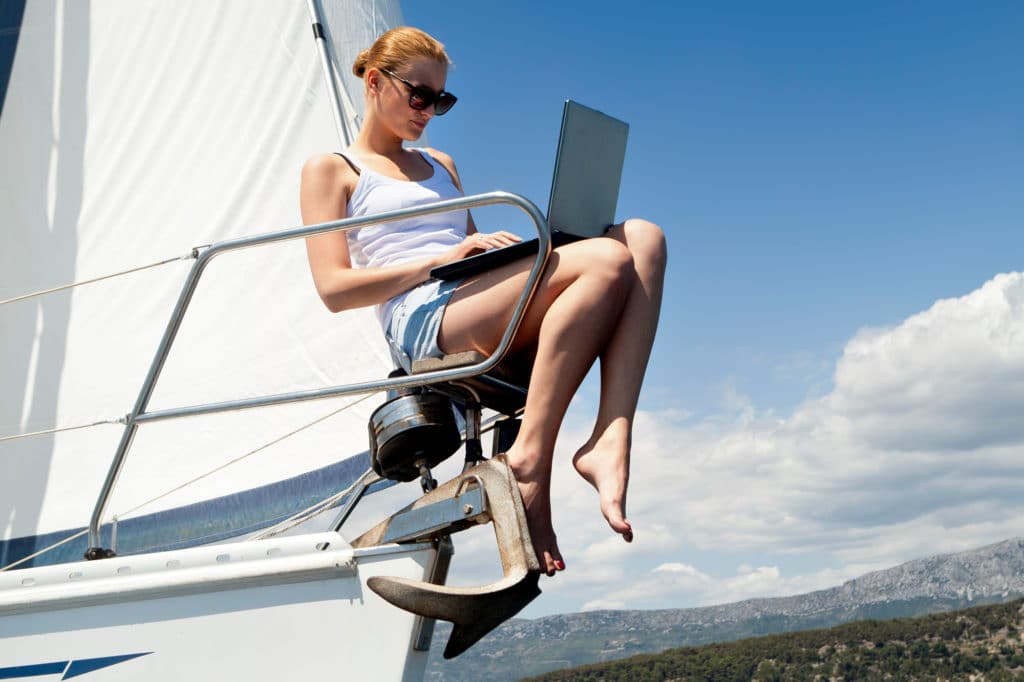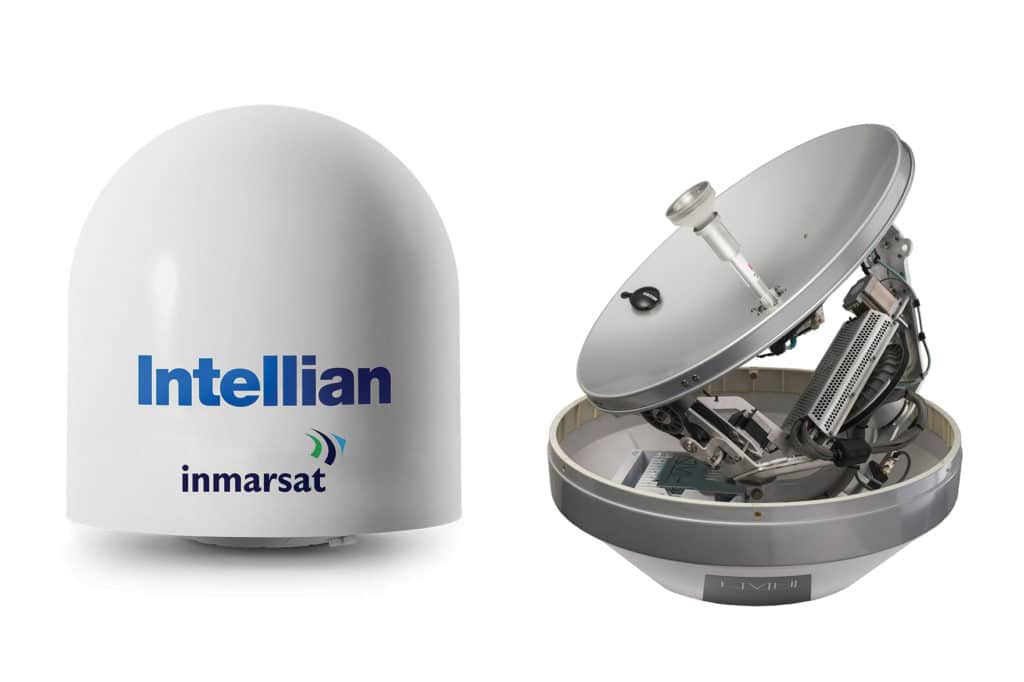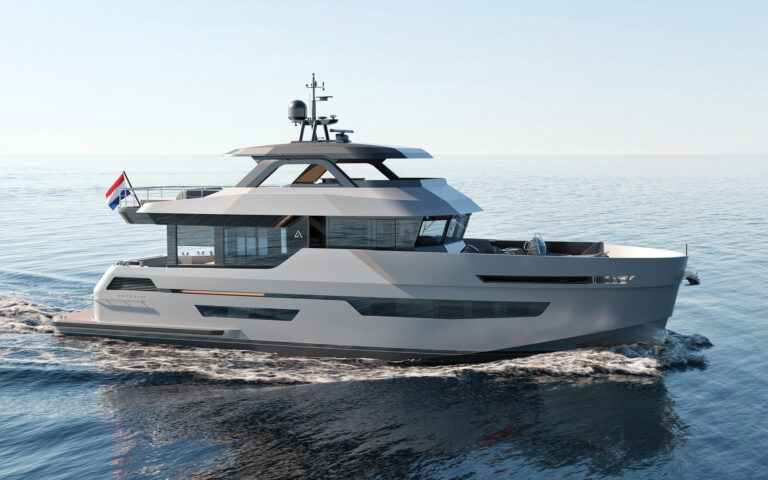
Many aspects of life changed in 2020, and one trend that accelerated rapidly is working remotely. For yacht owners and charterers, remote work can mean working from on board while casting off the dock lines. This alluring option provides prized social distancing and family time, but it also hinges on fast, seamless connectivity at sea.
While personal computers, printers and smart devices are all part of the floating-office ecosystem, the more important prerequisites for creating a robust onboard office are satcom systems. These systems rely on two ingredients: equipment that is mounted (such as an antenna) and housed belowdecks and the network of satellites this equipment uses to send and receive data. Owners can invest in an open system, buying equipment from one vendor and airtime service from a third-party provider, or can install an end-to-end system, with equipment and airtime from the same company.
Both options have merits. Open systems let yachtsmen hand-pick airtime providers when cruising to areas where one might deliver better coverage than another, while end-to-end systems offer seamlessness and a single contact if issues arise. There are numerous hardware players afield, especially in the open-system market. Intellian is a leading manufacturer of network-agnostic equipment, while KVH is a leading end-to-end manufacturer with a proprietary satcom network.
“It’s all about data throughput,” says Paul Comyns, Intellian’s vice president of global marketing, pointing to the company’s V65 and V100NX as options for floating-office antennas. “Uplink and downlink speeds are determined by the airtime provider and how much the customer wants to pay. If you just want to send email or make voice calls, slower-speed connectivity works. But if you want to take Zoom meetings, make video calls, or attend or host webinars, this requires greater bandwidth.”
Generally speaking, an airtime plan that delivers minimum speeds of 2 megabits per second for both uplink and downlink data is enough to support email, enterprise-level software such as Salesforce, and videoconferencing. As a reference, Apple’s FaceTime and Skype both require speeds of 1 to 4 Mbps.
Andrew Bush, KVH’s superyacht group sales director for Europe, the Middle East, Africa and Asia-Pacific, says another way to think about speeds is that if a boater is just sending and receiving email, he can use the same internet connections from five or six years ago. Sending and receiving large attachments or videos, and participating in videoconferencing, requires faster connections.
Bush points to KVH’s TracPhone V7-HTS, which delivers speeds up to 10/3 Mbps (downlink and uplink), or the TracPhone V11-HTS, which delivers speeds up to 20/3 Mbps, on KVH’s mini-VSAT Broadband network. With video calls and videoconferencing, Bush says, “You can get away with a slow connection, but it’s not quality. It gets compressed. It’s the difference between standard TV and high-definition.”
Comyns says two kinds of open-system airtime contracts are available. With unmetered plans, owners pay for a committed information rate and can stream unlimited amounts of data; the only limiting factor is the size of the CIR data pipeline. With metered plans, owners buy monthly (or weekly, for charterers) data allotments and then purchase additional megabytes of data once the allotted pool is depleted, similar to early cellphone plans.
Overall, if an owner or charterer needs high-quality videoconferencing and the ability to access enterprise software, Comyns says, they “want a CIR. There are no data overages, and they get unlimited access, just like at home.”

Alternatively, KVH’s V7-HTS and V11-HTS systems provide dual channels: a high-speed metered connection and a slower but unlimited-use channel. Here, Bush says, owners or charterers can reserve the fast-connection channel for their business needs, while reserving the unlimited channel for family and crew use. This latter point is especially important when wireless devices are involved. Smartphones, Bush says, use a lot of background data.
KVH’s mini-VSAT Manager can also help to manage data use. “Owners and captains can see what data is being used, and they can restrict certain types of data so the crew isn’t using all the bandwidth,” says Steve Gorman, KVH’s superyacht group field engineer. Additionally, KVH’s in-house team monitors data use and can recommend different plans if they notice significant data-use spikes.
Cost is an obvious consideration for any satcom customer, but Comyns says there are occasional disconnects between the equipment’s purchase price and its long-term airtime costs.
“A 1-meter antenna is the optimum size,” Comyns says, because “the cost of bandwidth is less for the same speed compared with a 60- or 70-centimeter antenna.” It’s more expensive for airtime providers to send signals to smaller antennas; Comyns and Gorman say owners are wise to select the largest antenna their yacht can accommodate.
Geography is the last major consideration. Years ago, as vessels traveled globally, crewmembers had to swap out each antenna’s radio-frequency component module so the system could employ regional signals. Those days, fortunately, are astern.
“One antenna will work around the world without any change,” Comyns says, adding that satcom systems are GPS-enabled and know which satellites to track. Gorman agrees: “You can cruise around the world, and it’s all done for you.”
Latitude, however, remains a hurdle. Because satellite communications are line of sight, and because geostationary satellites are situated above the equator, yachts cruising to high-latitude zones need to point their antennas toward the far southern horizon. Fortunately, Comyns says, most airtime providers give multiple satellite options. He cites the example of a yacht berthed in Juneau, Alaska: “If a cruise ship arrives, it could block your signal.” The solution is to switch satellites or, as a last resort, reposition the yacht.
Blockage can also occur much closer to the equator. For example, sky-scratching hotels, cruise ships or even a yacht’s own superstructure can block signals. Because of this problem, many yachts have dual satellite-communications antennas. If one gets blocked, the other remains online.
Overall, to equip a yacht as a floating office, consider buying the biggest antenna that fits, and tether it to an airtime plan with ample data. Or while chartering, insist on a properly equipped yacht. The turnkey costs aren’t trivial, but the ability to work from the boat is priceless.









